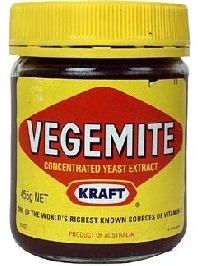
Learn how to serve Vegemite for a taste of Australia
Before you can be interested in how to serve vegemite, you have to know what it is. Many Americans do not have the faintest idea. Australians, however, refer to it as the ‘Food of Gods.’
Vegemite is a famous Australian condiment, invented by Dr. Cyril Callister, a chemist, in 1922. It’s pungent and gooey, dark brown in color.
Created out of leftover brewer’s yeast extract, a derivative of beer manufacturing, it is mixed with spice additives, including salt and wheat, and vegetables.
Australia’s famous Vegemite is spread on toast, sandwiches, cracker biscuits and crumpets or used as a pastry filler.
An Acquired Taste
Much like coffee, beer, oysters and sardines, this paste is an acquired taste, which means it is something a person comes to like through experience. Some people covet this spread while others detest it.
~
Vegemite is slightly bitter, salty, smooth, malty and an odd looking dark brown paste, possessing a knock of atypical flavor.
Rich in umami, meaning it boasts a pleasant savory taste, humans taste umami through receptors for glutamate (monosodium glutamate). Umami is one of the five basic tastes including sweet, sour, bitter, salty and savory.
Filled with vitamins, including folate, B1 (thiamin), B2 (riboflavin) and B3 (niacin), there is no fat content. These particular vitamins induce energy and vitality as well as improve brain function and support the nervous system. Folate prevents fatigue.
A shelf staple product, once opened it can be stored in the pantry or cupboard.
How to Eat It
Those in the know consider the bread the paste is spread on equally important as the paste itself. Connoisseurs warn it doesn’t taste good on sugary bread, but does taste good on virtually all other breads.
Toast two slices of bread lightly. Liberally spread butter on the bread. Put a little bit of the paste on a knife and scrape it over the bread. The mistake Americans make is thinking the product is comparable to peanut butter and they spread it on too thickly. Less is definitely more in this case, according to Australians who have been eating this condiment almost since birth. The product must be thinly spread on buttered toast to taste as it should. It is a condiment, not a main dish.
The product has a distinct smell, comparable, some say, to a complex meaty aroma, foreign to Americans, who think it smells strange. Not bad, just strange.
Do Not …
… Stick your finger in the container and then lick the substance off your finger. This delivers too much punch and will knock your socks off.
How to use It
Some cooks put a spoonful of the product in tomato sauce or a bit in white or brown gravy. Others like to add it to meatloaf or hamburger. Another method, add a dab to stock-based sauces and stews. Cooks say it improves the flavor of cooked food.
Different Strokes
An entire nation (Australia) worships this condiment while Americans are unfamiliar with it and when they are introduced they run away as fast as they can. Why is this?
Some maintain you have to be introduced to it as a child to acquire a taste for it. Introduction later in life doesn’t work as well but that doesn’t mean you shouldn’t give it a shot.
Statistics
An astronomical 22.7 million jars of this product are manufactured yearly in Australia. Thirty jars are bought in that county for every one exported. It is found in nine out of 10 pantries in Australian homes.
Maybe you should give it a try. You may become a devotee.
